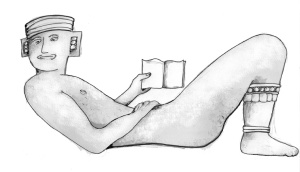Sorrentino & Servillo in Paris for Il Divo and L’uomo in Più
The Italian actor Toni Servillo and the director Paolo Sorrentino were in Paris during the last week of November, 2008, to introduce the new film “Il Divo” to the Parisian public. It was a chance to get to know these two important figures in today’s cinematic and theatrical arts in Italy through films, discussions and presentations sponsored by the Italian Cultural Institute, Le Latina Cinema and La Libreria Bookstore.
Servillo and Sorrentino have both worked with Teatri Uniti Napoli for many years, a place of experimentation and cultural interaction that helped to form them. What gives these two artist their exceptional power is the way they have mixed the cultures of both North and South Italy in such a dynamic way. I use “North” and “South” for want of a better term, since in reality, Italy is not so neatly divisible into North and South, though that is the historic origins of the different cultures. It is more like a schizophrenia, like two boots walking, though from the side we can only see one. And just as two legs can walk much more efficiently than one leg can hop, Italy has made its greatest progress, especially artistically, when the two boots have worked together.
We can see this in Servillo’s work, especially in the character of Giulio Andreotti, the infamous leader of the Christian Democratic Party in the 1980s. Andreotti is a product of the Southern political machine who has managed to ride the turbulent and ruthless political game of Roman power. Paolo Sorrentino also displays this ability to meld the powers of North and South, with his screenplays for Il Divo and another film presented in Paris, L’Uomo in Più from 2001.
This screening of L’Uomo in Più, was very revealing and an unexpected delight. In this film, Servillo plays a Neapolitan pop singer in a story that juxtaposes the singer’s career with another local hero with the same name, an unsuccessful soccer player. Tony Servillo has an amazing ability to use his plastic features in the service of his art. As Pisapio, the smarmy Neapolitan pop singer, with the hedonistic tendencies, his features are in constant movement, as he croons, flirts, threatens and snorts coke. It is delightful to see Servillo play this role, for he is flamboyant without ever becoming a caricature, and he is very convincing. It is not surprising to learn that both Sorrentino and Servillo won David di Donatello awards for their work in this film. The David is the Italian oscar.
The film was a complete opposite of Il Divo. As Andreotti, Servillo’s features are a blob of frozen lava. Sorrentino puts the cameras in constant movement, to give life to the dead weight of Andreotti’s existence. The camera moves in and out, the characters slide sideways across the scene. There is a dynamic use of intersplicing, for example, the images of a horserace that Andreotti attends and the Mafia hit on Salvo Lima
Though it was hard to see the connection between this completely cinematic style and theatrical direction, Paul Sorrentino made a point of crediting referred to his work with Teatri Uniti when he spoke about his work at Le Nouveau Latina in Paris. He said that although the theater occupies a different artistic space, his years at Teatri Uniti inspired his film work. Specifically, it helped him to learn how to focus in his films, to stay close to the essence of his story. This was extremely important because it is so easy to get lost in the infinite potential of cinema, and to lose the thread of the story.
Sorrentino does have certain theatrical devices up his sleeve, too. In both films, Il Divo and L’Uomo in Più, Sorrentino has written a closing monolog for Servillo’s character, a scene that Servillo has called “a gift” from Sorrentino to him, in that it gives Servillo the opportunity to put all his rhetorical talents on display, unraveling his story directly into the camera with a physical and psychological power that emanates solely from the nuances of his voice. His is an eruption of ideas of mental constructions that spew with volcanic force, great redhot heaps of emotion. Coming from the wooden figure of Andreotti, the monolog is shocking and deeply effective. It is no less effective from the otherwise inarticulate Pisapio in L’Uomo in Più, and it is a great use of Sorrentino and Servillo’s theatrical expertise.
Il Divo. Giulio Andreotti’s battle for power becomes a cinematic spectacle
November, 2008:
Paolo Sorrentino’s film is a complex story of the ruthless scramble for power in late Twentieth Century Rome. Aldo Moro is kidnapped and murdered, Police chiefs, journalists and judges are assassinated. Suicides shoot and hang, and Giulio Andreotti reaches for the ultimate prize, the Presidency of the Republic.

Toni Servillo at the European Film Awards. (Runeevensenscanpix)
In this film, “Il Divo” director Paolo Sorrentino gives a taste of the phantasmagorical world of Giulio Andreotti’s career. Mondo Andreotti is a place of imperial intrigue, a web of interlinked manipulations from Church, Mafia and corrupt officials. As texts on the screen inform us, half submerged criminal activities, like the P2 of the 1970s, the international Masonic lodge promoting rightwing dictatorship, and the Tangentopoli corruption scandals of the 1990s are the leitmotif of Andreotti’s career. Conspiracies seem so common that no one is able to fathom the layers of secret interest behind any political move, so people give up trying. It is this war of attrition that Andreotti plays in order to reach the heights of power. He is reviled, betrayed and indicted repeatedly, but he always manages to outlive his enemies and his competition. One of the competitors that he easily survives is the former Prime Minister, Aldo Moro, a character that becomes a true nemesis as he haunts Andreotti’s thoughts.
Sorrentino easily blends many cinematic styles to create this energetic film. There are action sequences and documentary style use of text and voiceover. There are nods to Coppola and Fellini in some of the scenes of extravagances, This is evident in the frenzy of an inauguration party, which the camera enters from afar. There are young dancers gyrating to the sounds of a percussion band in an opulent palatial space. However, the celebration is grotesque, it seems more aggressive than entertaining, an unpleasant, enforced festivity that seems to build power more than release tension. In the midst of this sumptuous room that could be straight out of Ancient or Renaissance Rome, Andreotti sits like a king, barely acknowledging the queue of sychophants waiting their turn to perform the rituals of obeisance. As if to underscore this, elsewhere in the film, Senator Rino Formica is quoted as saying that Andreotti carries inside him 2000 years of history, from the trial of Jesus to legend of Pope Joan and the politics of the Borgias and beyond.
Giulio Andreotti is played by the great actor Toni Servillo, who manages to imbue this eerie creature with a seething energy. Standing stiff, with his shoulders hunched in Andreotti’s signature slouch, Servillo is like a lizard blending into the landscape, only betrayed by the unseemly flick of his tongue or the wring of his hands.
The screenplay does not have a story that develops in a coherent way, it is instead a story of the interaction of layers of power, like a cutaway slice of the earth’s crust showing all the layers of sediment, dead rock, earthworms, fossils and dirt. The story moves up and down these layers, as Andreotti conspires unsuccessfully to turn his several stints as Prime Minister into the ultimate achievement, Presidency of the Republic. Through it all, we see scenes of Aldo Moro, the leader of the Christian Democratic Party, in his solitary captivity in a Red Brigades prison, writing his letters of condemnation of this Christian Democratic circus. Moro was kidnapped by the Red Brigades in 1978 and imprisoned for 55 days. The Red Brigades terrorists played with Moro like a toy, dangling photos and letters from him before the Italian press, before finally extinguishing his life and dumping his body in the trunk of a car. The captive Moro is portrayed as an almost metaphysical force, the conscience of the Christian Democratic Party and the letters that he writes accusing Andreotti of malfeasance from his cell haunt Andreotti throughout the following decades of his power. It is these accusations, as well as Andreotti’s own quilty recognition of his own unworthiness that cause a second level of migraine headaches that intensify those he already suffers from throughout his entire life.
Moro gets the last word, saying that Andreotti, being free of the wisdom and flexibility and human fervor that marks a great political figure, may in fact remain there on the scene for a great period of time, but when he leaves, he will leave without a trace. These are the words that haunt Andreotti at the end, and they seem to have already come true. It will likely surprise audiences to learn that to this day Andreotti is still alive and in fact, still a Senator for life in Italy, so irrelevant has his reign become. His was ambition rather than vision, power rather than governance, and he has sunk into the obscurity of current events gone stale, rather than into history. He is like a black hole that has burned down into the heart of Italian political life, and as that hole heals, he will disappear inside.
-
Archives
- July 2015 (1)
- June 2015 (1)
- November 2014 (1)
- July 2014 (1)
- June 2014 (4)
- September 2012 (1)
- August 2012 (1)
- March 2012 (3)
- February 2012 (3)
- October 2011 (1)
- September 2011 (5)
- August 2011 (3)
-
Categories
-
RSS
Entries RSS
Comments RSS







